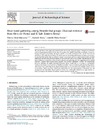Identificador persistente para citar o vincular este elemento:
https://accedacris.ulpgc.es/jspui/handle/10553/74736
| Campo DC | Valor | idioma |
|---|---|---|
| dc.contributor.author | Vidal Matutano, Paloma | en_US |
| dc.contributor.author | Henry, Auréade | en_US |
| dc.contributor.author | Théry-Parisot, Isabelle | en_US |
| dc.date.accessioned | 2020-10-14T11:58:23Z | - |
| dc.date.available | 2020-10-14T11:58:23Z | - |
| dc.date.issued | 2017 | en_US |
| dc.identifier.issn | 0305-4403 | en_US |
| dc.identifier.uri | https://accedacris.ulpgc.es/handle/10553/74736 | - |
| dc.description.abstract | We present here a new approach combining the microscopic characterization of fungal decay features and the fragmentation degree of the charcoal remains from Middle Palaeolithic combustion structures: features H4 and H11 from Abric del Pastor, unit IV (>75 ka BP) and features H50 and H57 from El Salt, unit Xb (ca. 52 ka BP), Eastern Iberia. The observation of wood degradation patterns that occurred prior to charring followed by their quantitative analysis according to previous experimental studies revealed differences between the alteration degrees of the firewood used in the hearths, highlighting the existence of firewood acquisition criteria based on dead wood gathering and also suggesting smoke-related functions. Coupled with fragmentation analyses, this method highlighted possible post-depositional processes affecting the higher degraded charcoals. These results lead us to propose a quantitative analysis of the fungal decay patterns on Middle Palaeolithic charcoal reinforcing the previous hypotheses about dead wood gathering among Neanderthal groups as an accessible and available resource in the surroundings. These data have significant implications for the interpretation of firewood use and management by Palaeolithic hunter-gatherers which was traditionally defined as an opportunistic activity according to the absence of selection criteria based on specific taxa. | en_US |
| dc.language | eng | en_US |
| dc.relation.ispartof | Journal of Archaeological Science | en_US |
| dc.source | Journal of Archaeological Science [ISSN 0305-4403], v. 80, p. 109-121 (April 2017) | en_US |
| dc.subject | 241710 Paleobotánica | en_US |
| dc.subject | 550405 Prehistoria | en_US |
| dc.subject.other | Abric del Pastor | en_US |
| dc.subject.other | El Salt | en_US |
| dc.subject.other | Middle Palaeolithic | en_US |
| dc.subject.other | Charcoal analysis | en_US |
| dc.subject.other | Fuel management | en_US |
| dc.subject.other | Fungal degradation of wood | en_US |
| dc.title | Dead wood gathering among Neanderthal groups: Charcoal evidence from Abric del Pastor and El Salt (Eastern Iberia) | en_US |
| dc.identifier.doi | 10.1016/j.jas.2017.03.001 | en_US |
| dc.description.lastpage | 121 | en_US |
| dc.description.firstpage | 109 | en_US |
| dc.relation.volume | 80 | en_US |
| dc.investigacion | Artes y Humanidades | en_US |
| dc.type2 | Artículo | en_US |
| dc.utils.revision | Sí | en_US |
| dc.identifier.ulpgc | Sí | en_US |
| dc.description.sjr | 1,885 | |
| dc.description.jcr | 3,061 | |
| dc.description.sjrq | Q1 | |
| dc.description.jcrq | Q1 | |
| dc.description.ahci | AHCI | |
| dc.description.scie | SCIE | |
| dc.description.ssci | SSCI | |
| dc.description.erihplus | ERIH PLUS | |
| item.fulltext | Con texto completo | - |
| item.grantfulltext | open | - |
| crisitem.author.dept | GIR Investigación en Arqueología y Patrimonio | - |
| crisitem.author.orcid | 0000-0002-5892-149X | - |
| crisitem.author.parentorg | Departamento de Ciencias Históricas | - |
| crisitem.author.fullName | Vidal Matutano,Paloma | - |
| Colección: | Artículos | |
Citas de WEB OF SCIENCETM
Citations
60
actualizado el 08-jun-2025
Visitas
123
actualizado el 26-ene-2025
Descargas
316
actualizado el 26-ene-2025
Google ScholarTM
Verifica
Altmetric
Comparte
Exporta metadatos
Los elementos en ULPGC accedaCRIS están protegidos por derechos de autor con todos los derechos reservados, a menos que se indique lo contrario.
